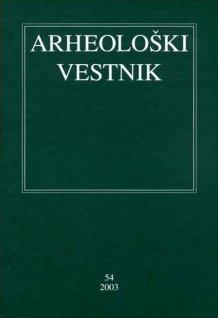The Role of Nauportus (Vrhnika) in the light of new epigraphic texts
Keywords:
Slovenia, Roman period, Nauportus (Vrhnika), epigraphy, wine slips/grape plantings, Roman fish sauce, textile production, tradeAbstract
Four lead tablets, discovered in 2005 at Nauportus (Vrhnika) and published by M. Lovenjak in 2009, are interesting testimonies for the process of Romanization in the age of Augustus. A partially new reading of the first tablet refers to the trade in young grapevine plants. Further details inform us about the costs and the clay pots containing the seedlings. The introduction of the Roman wine culture to the Transalpine area was related to high initial investment capital. The prohibition by the Romans of new plantations of grapes and olives in the second century BC, probably related to the Histri and Iapodes, was no longer in effect when the text was written. The importation of Roman fish sauce mentioned on the second tablet, probably for soldiers in Nauportus, is an outstanding testimony to the spread of Roman culinary preferences and their way of life. Two poorly legible tablets refer to the import of wool and short tunics, indicating that textile production was already developed in Nauportus. The tablets were attached to containers or bales and reveal the usual Roman trade practices, based on monetary transactions and accounting.
Downloads
References
AIGNER, H. 1990, Zum Weinbau im Altertum. – In: Weinkultur, 135–152, Graz.
BINSFELD, W. 1997, Gefäßnamen auf Keramik im Nordwesten des Römischen Reiches. – Trierer Zeitschrift 60, 19–31.
BUORA, M., S. MAGNANI 2015, Una lamina in piombo iscritta da Moruzzo e l’importazione di viti dal Lazio nell’agro di Aquileia in età trainanea. – In: Le iscrizioni con funzione didascalico-esplicativa, Aquileia.
CURTIS, R.I. 1984, “Negotiatores Allecarii” and the Herring. – Phoenix 38, 147–158.
DE ANGELIS, A. 1995, La coltivazione delle piante da frutto nella letteratura agronomica latina dalla produzione alla conservazione dei frutti. – Varia / Academiae Latinitati Fovendae 6, Rom.
EHMIG, U. 1995, Allex oder Anderes. – Mainzer Archäologische Zeitschrift 2, 117–130.
FRANCE, J., J. NELIS-CLÉMENT 2014, La statio. Archéologie d’un lieu de pouvoir dans l’empire romain. – In: J. France, J. Nelis-Clément (eds.), La statio. Archéologie d’un lieu de pouvoir dans l’empire romain, 11–16, Bordeaux.
GLEISCHER, P. 2014, Eisenzeitliche Opferplätze und Heiligtümer im Südostalpenraum: Fakten, Thesen, Zweifel. – Rudolfinum 2014, 132–148.
GOSTENČNIK, K. 2014, Textilproduktion in der Austria Romana. – In: K. Grömer, (ed.), Römische Textilien in Noricum und Westpannonien im Kontext der archäologischen Gewebefunde 2000 v. Chr. – 500 n. Chr. In Österreich, 57–109, Graz.
GROH, S., H. SEDLMAYER 2007, Kultpraktiken am norisch-römischen Kultplatz Frauenberg (Österreich). – In: S. Groh, H. Sedlmayer (eds.), Blut und Wein. Keltisch- -römische Kultpraktiken, Protohistoire Européenne 10, 165–192, Montagnac.
HILGERS, W. 1969, Lateinische Gefäßnamen. Bezeichnungen, Funktion und Form römischer Gefäße nach den antiken Schriftquellen. – Düsseldorf.
HOFMANN, J. B., A. SZANTYR 1965, Lateinische Syntax und Stilistik. – München.
HORVAT, J. 2009a, Nauportus – a settlement at the beginning of the transportation route along the Ljubljanica. – In: P. Turk, J. Istenič, T. Knific, T. Nabergoj (eds.), The Ljubljanica – a River and its Past, 96–101, Ljubljana.
HORVAT, J. 2009b, Nauportus – naselje na začetku transportne poti po Ljubljanici. – V: P. Turk, J. Istenič, T. Knific, T. Nabergoj (ur.), Ljubljanica – kulturna dediščina reke, 89–94, Ljubljana.
JASHEMSKI, W.F. 1992, Vasa Fictilia: Ollae Perforatae. – In: R. M. Wilhelm, H. Jones (eds.), The Two Worlds of the Poet. New Perspectives on Vergil, 371–391, Detroit.
KENAWI, M., E. MACAULAY-LEWIS, J. S. McKENZIE 2012, A commercial nursery near Abu Hummus (Egypt) and re-use of amphoras for the trade in plants. – Journal of Roman archaeology 25, 195–225.
KRAMER, D. 1990, Aus der Ur- und Frühgeschichte der Weinkultur. – In: Weinkultur, 21–37, Graz.
LOVENJAK, M. 2009a, 45. Four inscribed plates. – In: P. Turk, J. Istenič, T. Knific, T. Nabergoj (eds.), The Ljubljanica – a River and its Past, 268–271, Ljubljana.
LOVENJAK, M. 2009b, 45. Štiri ploščice z napisi. – V: P. Turk, J. Istenič, T. Knific, T. Nabergoj (ur.), Ljubljanica – kulturna dediščina reke, 244–247, Ljubljana.
MACAULAY-LEWIS, E. R. 2006a, Planting pots at Petra: a preliminary study of ollae perforatae at the Petra Garden Pool Complex and at the ‘Great Temple’. – Levant 38, 159–170.
MACAULAY-LEWIS, E. R. 2006b, The role of ollae perforatae in understanding horticulture, planting techniques, garden design, and plant trade in the Roman World. – In: J.-P. Morel, J. Tresserras Juan, J. C. Matamala (eds.), The archaeology of crop fields and gardens, Proceedings of the 1st Conference on Crop Fileds and Gardens Archaeology, Barcelona (Spain), 1-3 June 2006, 207–219, Bari.
MESSINEO, G. 1984, Ollae perforatae. – Xenia 8, 65–82.
MIHĂESCU, H. 1978, La langue latine dans le Sud-Est de l’Europe. – Bukarest.
NELIS-CLÉMENT, J. 2006, Les stations comme espace et transmission du pouvoir. – In: A. Kolb (ed.), Herrschaftsstrukturen und Herrschaftspraxis. Konzepte, Prinzipien und Strategien der Administration im römischen Kaiserreich, 269–298, Berlin.
PATERSON, J. 1978, Transalpinae gentes: Cicero, De Re Publica 3.16. – The Classical Quarterly 28, 454–458.
TCHERNIA, A. 1986, Le vin de l’Italie romaine. Essai d‘histoire économique d‘après les amphores. – Bibliothèque des Écoles françaises d’Athènes et de Rome 261.
THÜRY, G.E. 2007, “Erbärmlichst lebende Menschen”? Vom Pannonienbild der Südländer und von Ernährung und Lebensqualität im frühen Carnuntum. – In: Legionsadler und Druidenstab. Vom Legionslager zur Donaumetropole, Katalog des Niederösterreichischen Landesmuseums 462, 337–345.
TIEFENGRABER, G., C. GRILL 2007, Neue Forschungen zum keltischen Kultplatz Perl-/Stadläcker am Frauenberg bei Leibnitz/Steiermark (Österreich). – In: S. Groh, H. Sedlmayer (eds.), Blut und Wein. Keltisch-römische Kultpraktiken, Protohistoire Européenne 10, 155–164, Montagnac.
Downloads
Published
How to Cite
Issue
Section
License

This work is licensed under a Creative Commons Attribution-NonCommercial-ShareAlike 4.0 International License.
Authors guarantee that the work is their own original creation and does not infringe any statutory or common-law copyright or any proprietary right of any third party. In case of claims by third parties, authors commit their self to defend the interests of the publisher, and shall cover any potential costs.
More in: Submission chapter





